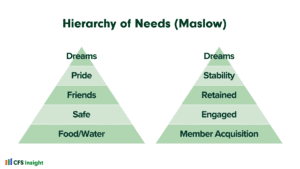Many credit union analytics professionals will have some variation on the following story.
“The client came to me and wanted to deploy an analytics solution that was an urgent problem. I was able to create a solution in record time, and it addressed the very issue that the client was having. After it was deployed, no one ever used it.”
It would be great if this was an isolated incident or was specific to one user, group, company, or industry. Unfortunately, unused analytic solutions are all too common.
There are, of course, no numbers on how many of these solutions get deployed and are never used. For good or ill most Credit Unions have no process to look at the solutions that are deployed, evaluate their usage and ROI, and figure out if there is a gap between expectation and reality. But in this blog, we will look at some of the common causes and offer some advice on solutions.
Why Does this Happen?
There are a variety of reasons why this can happen. Identifying the most likely issues will help you create a plan to overcome the barriers.
It’s Not the Default Solution
The most common reason a new solution doesn’t get used is because it is not the default. The default in any situation is very powerful. In fact, it is so strong that many behavioral economists have dedicated whole books to the topic. Whatever that employee has been doing for the previous year, two or even ten years, is difficult to walk away from, even when the new solution is better. Richard Thaler and Dan Ariely reference a story where a group of professional skaters refused a new skate design even though it was faster. This is a group of people whose livelihood depends on going faster, and they still refuse.
The first option to getting adoption is to choose someone in the organization that is a natural early adopter even if they don’t represent the most pressing or the largest ROI opportunity. Getting some early wins with analytical solutions can be enough to show both management and other groups that making the change and using new tools is worth the effort.
Another option is to have management set specific goals with a predefined timeline for improvements. Expecting improvements with no plan and no timeline usually results in poor results. But this requires that management is involved enough to craft detailed expectations.
If the solution is replacing something currently being used, setting a sunset date is a way to help force the changeover. This helps create the two primary factors needed to create change; Changing the default and doing it along a specific timeline.
Didn’t Understand The Data Analytics Solution
Sometimes the person who should be using the solution doesn’t understand some portion of it. It could be that they don’t understand why a change is needed, how the solution works, or it fits into some more extensive process. It can be difficult for some to say, ‘I don’t understand,’ so you normally have to find a subtle way to tease out a lack of understanding. Adding an introduction tab to the solution can help address these issues. It should state why the solution was created, where the data comes from, if a model is applied, explain how it works in simple terms, and where this sits in a larger process.
No Time For Data Analytics
You will often hear people say they didn’t adopt a solution because they didn’t have the time. It is easy for this to be a catch-all for the other two barriers that we looked at. But sometimes the person who needs to do the work really is too busy to take on a new task. This is another place where having management’s involvement will help. You will need them to both make analytics a priority but also remove other items from their responsibility. Simply adding another requirement to someone already busy usually creates more problems than it solves.
Cultural Issues Credit Unions Face
There are a variety of cultural issues Credit Unions face that can create roadblocks that are significantly harder to solve when compared to previous issues. Cultural issues like ‘Not created here,’ political infighting, extreme CYA, or, in some cases, very toxic individuals are allowed to operate with impunity. The cultural issues must be addressed before any real progress is likely to be made. They are antithetical to the idea of using data and analytics to make better decisions. This topic is vast and has a variety of books available depending on the specifics of the cultural issue. Some options are here and here.
– Credit Union Data Analytics and Modeling
Empower your credit union with data-driven decision making
Identify risk, growth, and value opportunities by integrating, modeling, and analyzing your data.
Conclusion
While every environment is different, these are some of the most common that arise when trying to deploy a data analytics solution and to get adoption.




